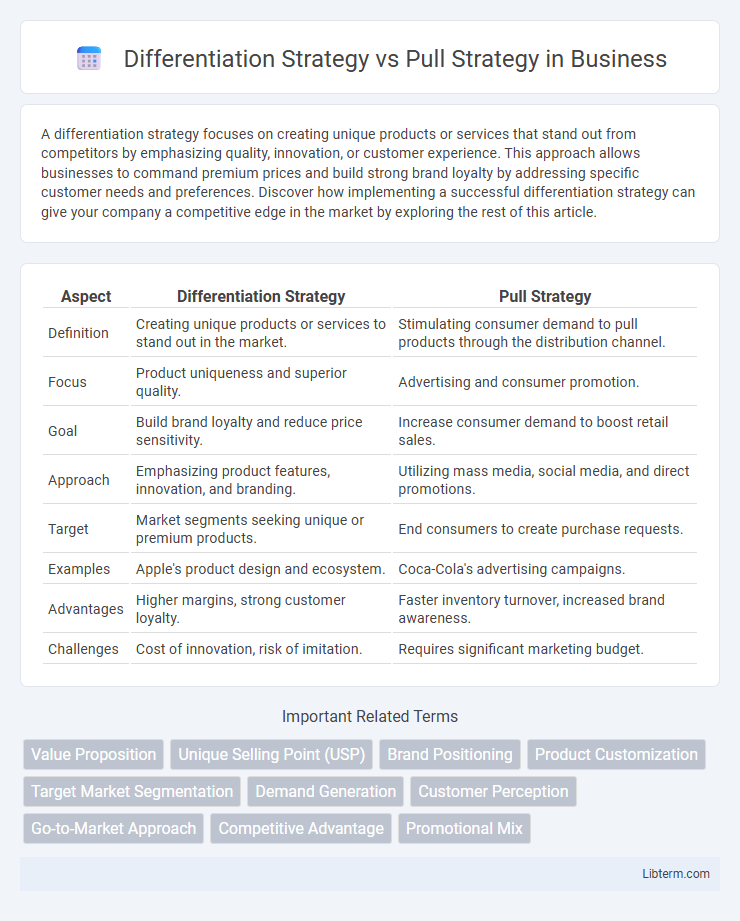A differentiation strategy focuses on creating unique products or services that stand out from competitors by emphasizing quality, innovation, or customer experience. This approach allows businesses to command premium prices and build strong brand loyalty by addressing specific customer needs and preferences. Discover how implementing a successful differentiation strategy can give your company a competitive edge in the market by exploring the rest of this article.
Table of Comparison
| Aspect | Differentiation Strategy | Pull Strategy |
|---|---|---|
| Definition | Creating unique products or services to stand out in the market. | Stimulating consumer demand to pull products through the distribution channel. |
| Focus | Product uniqueness and superior quality. | Advertising and consumer promotion. |
| Goal | Build brand loyalty and reduce price sensitivity. | Increase consumer demand to boost retail sales. |
| Approach | Emphasizing product features, innovation, and branding. | Utilizing mass media, social media, and direct promotions. |
| Target | Market segments seeking unique or premium products. | End consumers to create purchase requests. |
| Examples | Apple's product design and ecosystem. | Coca-Cola's advertising campaigns. |
| Advantages | Higher margins, strong customer loyalty. | Faster inventory turnover, increased brand awareness. |
| Challenges | Cost of innovation, risk of imitation. | Requires significant marketing budget. |
Introduction to Differentiation and Pull Strategies
Differentiation strategy involves creating unique products or services that offer distinct value, allowing businesses to stand out in competitive markets and attract specific customer segments. Pull strategy focuses on generating consumer demand through targeted marketing efforts, encouraging customers to actively seek out and purchase the product. Both strategies emphasize driving market preference and enhancing brand loyalty by aligning product offerings with consumer needs and behaviors.
Defining Differentiation Strategy
Differentiation strategy involves creating unique products or services that offer distinct value compared to competitors, emphasizing innovation, quality, or brand reputation. It targets specific customer segments willing to pay a premium for exclusivity or superior performance, enhancing competitive advantage and market positioning. Effective differentiation relies on continuous research and development, strong branding, and customized marketing efforts to sustain customer loyalty and long-term profitability.
Understanding Pull Strategy
Pull strategy focuses on creating strong consumer demand by encouraging customers to actively seek out a product, often through targeted advertising, promotions, and social media engagement. This approach draws consumers toward the brand, increasing sales through direct interaction and brand loyalty. Unlike differentiation strategy, which emphasizes unique product features to stand out, pull strategy centers on building consumer desire and awareness to stimulate purchase intent.
Key Objectives of Differentiation vs Pull
Differentiation strategy aims to create unique product features or brand attributes that distinguish a company's offerings from competitors, enhancing perceived value and customer loyalty. The key objective is to build competitive advantage through innovation, quality, and brand identity that justify premium pricing and reduce price sensitivity. Pull strategy focuses on generating consumer demand to drive sales by encouraging customers to actively seek out the product, using targeted advertising, promotions, and strong brand positioning.
Core Elements of Differentiation Strategy
Core elements of a Differentiation Strategy include offering unique product features, superior quality, and exceptional customer service that distinguish a brand from competitors. This strategy emphasizes innovation, brand reputation, and targeted marketing efforts to create perceived value, enabling premium pricing. In contrast to Pull Strategy, which focuses on demand generation through advertising and promotions, Differentiation Strategy centers on developing intrinsic product advantages to attract and retain customers.
Mechanisms Behind Pull Strategy
Pull strategy mechanisms focus on creating consumer demand through targeted promotions, advertising, and direct engagement, encouraging customers to actively seek out products. It leverages brand loyalty, social proof, and emotional connections to stimulate interest and drive purchases. This approach contrasts with differentiation strategy by emphasizing demand generation rather than unique product features or competitive advantages.
Benefits and Challenges of Differentiation
Differentiation strategy enhances competitive advantage by offering unique product features and superior quality, which can lead to increased customer loyalty and higher profit margins. However, this approach requires significant investment in innovation, marketing, and maintaining distinctiveness, posing risks of imitation by competitors and higher operational costs. Successfully managing differentiation demands continuous innovation and effective communication to sustain perceived value in the target market.
Advantages and Drawbacks of Pull Strategy
Pull strategy builds strong customer demand by encouraging consumers to seek out products through advertising and promotions, enhancing brand loyalty and reducing the need for high distribution costs. Its advantages include creating direct customer engagement and fostering long-term relationships, which can lead to sustainable sales growth. However, drawbacks involve high initial marketing expenses and slower market penetration, making it less effective for new or low-awareness products that require immediate retailer support.
Comparative Analysis: Differentiation vs Pull
Differentiation strategy emphasizes creating unique product features and superior value to stand out from competitors, driving customer preference through innovation and quality. Pull strategy focuses on generating consumer demand directly, encouraging customers to actively seek the product via advertising and promotions. While differentiation builds brand loyalty through intrinsic product advantages, pull strategy leverages market communication to stimulate consumer interest and increase purchase intent.
Choosing the Right Strategy for Your Business
Choosing the right strategy for your business depends on whether you aim to emphasize unique product attributes through differentiation strategy or stimulate consumer demand directly via a pull strategy. Differentiation strategy leverages exclusive features, quality, or brand reputation to create competitive advantage, ideal for markets with high competition and price sensitivity. Pull strategy focuses on customer-driven demand generation through targeted advertising and promotions, suitable for brand-centric products seeking to build long-term loyalty and market presence.
Differentiation Strategy Infographic

 libterm.com
libterm.com